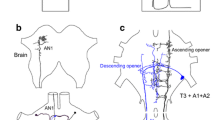Summary
Comparative study of phonotactic reactions of females of 5 species of crickets to the calling song (CS) of conspecific males and different sound models in Y-maze experiments showed:
-
1.
InGryllodinus kerkennensis the essential property of the signal is the continuity of the song (Fig 3).
-
2.
InGryllus campestris andG. bimaculatus pulse rate and chirp duration are important, the former having narrow and the latter broad tuning of reaction to chirp duration (Fig. 4).
-
3.
InSpecies 2 (see Methods) chirp rate and pulse duration determine the specific response of females (Figs. 5 and 6).
-
4.
InMelanogryllus desertus the most important parameters are the mean pulse rate and the increase in amplitude of pulses within the chirps (Fig. 7).
-
6.
The spectrum of the CS is not important for the process of recognition as far as it falls into the tuning curve of specialized low-frequency channel of the auditory system. High-frequency sounds outside the range of this channel are not effective even if they have the same amplitude modulation pattern as the CS.
The properties of phonotactic reaction of crickets are discussed. It is concluded that the system controlling the reaction works on the probability principle.
Similar content being viewed by others
References
Alexander, R.D.: Sound production and associated behavior in insects. Ohio J. Sci.57, 101–113 (1957)
Busnel, M.C., Busnel, R.G.: La directivité acoustique des deplacements de la femelled'Oecanthus pellucens Scop. In: Colloque sur l'acoustique des Orthoptères (ed. R.G. Busnel), pp. 356–364. Paris: Inst. Nat. Recherche Agron. 1954
Dathe, H.H.: Untersuchungen zum phonotaktischen Verhalten vonGryllus bimaculatus (Insecta, Orthopteroidea). Forma funct.1, 7–20 (1974)
Hill, K.G.: Carrier frequency as a factor in phonotactic behavior of female crickets (Teleogryllus commodus). J. comp. Physiol.93, 7–18 (1974)
Hill, K.G.: Acoustic communication in the Australian field cricketsTeleogryllus commodus andT. oceanicus (Orthoptera: Gryllidae). Thesis, Dept. Zool., Univ. Melbourne (1975)
Hill, K.G., Loftus-Hills, J.J., Gartside, D.F.: Premating isolation between the Australian field cricketsTeleogryllus commodus andT. oceanicus (Orthoptera: Gryllidae). Aust. J. Zool.20, 153–163 (1972)
Huber, F.: Central nervous control of sound production in crickets and some speculations on its evolution. Evolution16, 429–442 (1962)
Kutsch, W.: Neuromuskuläre Aktivität bei verschiedenen Verhaltensweisen von drei Grillenarten. Z. vergl. Physiol.63, 335–378 (1969)
Nevo, E., Blondheim, A.: Acoustic isolation in the speciation of mole crickets. Ann. Entomol. Soc. Amer.65, 980–981 (1972)
Popov, A.V.: Sounds of crickets from southern regions of the European part of the USSR. [In Russian.] Rev. Entomol. USSR51, 17–36 (1972)
Popov, A.V.: Frequency selectivity of the reaction of auditory neurons in the 1st thoracic ganglion of the cricketGryllus bimaculatus. [In Russian.] J. evol. biochem. Physiol.9, 265–277 (1973)
Popov, A.V., Shuvalov, V.F.: Spectrum, intensity and directional characteristics of the calling song emission in the cricketGryllus campestris under natural conditions. [In Russian.] J. evol. biochem. Physiol.10, 72–80 (1974)
Popov, A.V., Shuvalov, V.F., Knjazev, A.N., Clar-Spasovskaya, N.A.: Communication calling songs of crickets (Orthoptera, Gryllidae) from south-western Tadjikistan. [In Russian.] Rev. Entomol. USSR53, 258–279 (1974b)
Popov, A.V., Shuvalov, V.F., Markovich, A.M.: Spectrum of the calling songs, phonotaxis and the auditory system in the cricketGryllus bimaculatus. [In Russian.] J. evol. biochem. Physiol.2, 453–460 (1975)
Popov, A.V., Shuvalov, V.F., Svetlogorskaya, I.D., Markovich, A.M.: Acoustic behaviour and auditory system in insects. In: Mechanoreception (ed. J. Schwartzkopff), Symp. Bochum, 1973, pp. 281–306. Wiss. Abh. Rhein-Westf. Akad. Wiss. (1974a)
Regen, J.: Über die Anlockung des Weibchens vonGryllus campestris L. durch telephonisch übertragende Stridulationslaute des Männchens. Pflügers Arch. ges. Physiol.155, 193–200 (1913)
Rheinlaender, J., Kalmring, K., Popov, A.V., Rehbein, H.: Brain projections and information processing of biologically significant sounds by two large ventral cord neurons ofGryllus bimaculatus DeGeer (Orthoptera, Gryllidae). J. comp. Physiol.110, 251–269 (1976)
Roussel, J.-P.: Functions des corpora allata et controle de la pigmentation chezGryllus bimaculatus De Geer. J. Insect Physiol.13, 113–130 (1967)
Shuvalov, V.F., Popov, A.V.: The reaction of the females of the domestic cricketAcheta domestica to sound signals and its changes in ontogenesis. [In Russian.] J. evol. biochem. Physiol.7, 612–615 (1971)
Shuvalov, V.F., Popov, A.V.: Significance of some of the parameters of the calling songs of male cricketsGryllus bimaculatus for phonotaxis of females. [In Russian.] J. evol. biochem. Physiol.9, 177–182 (1973a)
Shuvalov, V.F., Popov, A.V.: The importance of the calling song rhythmic pattern of males of the genusGryllus for phonotaxis of females. [In Russian.] Zool. J.52, 1179–1185 (1973b)
Shuvalov, V.F., Popov, A.V.: Mechanisms of recognition by female crickets (genusGryllus) of the calling songs of conspecific males. [In Russian.] In: Evolutionary neurophysiology and neurochemistry (ed. Kreps, E.M.), pp. 37–43. Nauka: Leningrad 1976
Ulagaraj, S.M., Walker, T.J.: Response of flying mole crickets to three parameters of synthetic songs broadcast outdoors. Nature (Lond.)253, 530–532 (1975)
Walker, T.J.: Specificity in response of female tree crickets (Orthoptera, Gryllidae, Oecanthinae) to calling songs of the males. Ann. Entom. Soc. Amer.50, 626–636 (1957)
Walker, T.J.: Systematics and acoustic behaviour of United States crickets of the genusOrocharis (Orthoptera, Gryllidae). Ann. Entom. Soc. Amer.62, 752–762 (1969)
Zaretsky, M.D.: Specificity of the calling sond and short term changes in the phonotactic response by females cricketsScapsipedus marginatus (Gryllidae). J. comp. Physiol.79, 153–172 (1972)
Author information
Authors and Affiliations
Rights and permissions
About this article
Cite this article
Popov, A.V., Shuvalov, V.F. Phonotactic behavior of crickets. J. Comp. Physiol. 119, 111–126 (1977). https://doi.org/10.1007/BF00655876
Received:
Issue Date:
DOI: https://doi.org/10.1007/BF00655876




